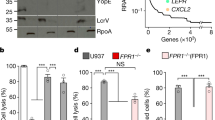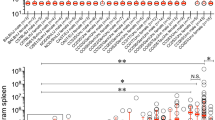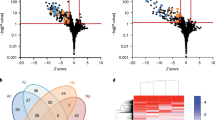Abstract
Laboratory mice are well known to be highly susceptible to virulent strains of Yersinia pestis in experimental models of bubonic plague. We have found that Mus spretus-derived SEG/Pas (SEG) mice are exceptionally resistant to virulent CO92 and 6/69 wild type strains. Upon subcutaneous injection of 102 colony-forming units (CFU), 90% of females and 68% of males survived, compared with only an 8% survival rate for both male and female C57BL/6 mice. Furthermore, half of the SEG mice survived a challenge of up to 107 CFU. The time required for mortality was similar between B6 and SEG, suggesting that survival is dependent on early rather than late processes. The analysis of 322 backcross mice identified three significant quantitative trait loci (QTLs) on chromosomes 3, 4 and 6, with dominant SEG protective alleles. Each QTL increased the survival rate by approximately 20%. The three QTLs function additively, thereby accounting for 67% of the difference between the parental phenotypes. Mice heterozygous for the three QTLs were just as resistant as SEG mice to Y. pestis challenge. The SEG strain therefore offers an invaluable opportunity to unravel mechanisms and underlying genetic factors of resistance against Y. pestis infection.
This is a preview of subscription content, access via your institution
Access options
Subscribe to this journal
Receive 6 digital issues and online access to articles
$119.00 per year
only $19.83 per issue
Buy this article
- Purchase on Springer Link
- Instant access to full article PDF
Prices may be subject to local taxes which are calculated during checkout






Similar content being viewed by others
References
Titball RW, Williamson ED . Vaccination against bubonic and pneumonic plague. Vaccine 2001; 19: 4175–4184.
Schrag SJ, Wiener P . Emerging infectious diseases: what are the relative roles of ecology and evolution? Trends Evol Ecol 1995; 10: 319–324.
Galimand M, Guiyoule A, Gerbaud G, Rasoamanana B, Chanteau S, Carniel E et al. Multidrug resistance in Yersinia pestis mediated by a transferable plasmid. N Engl J Med 1997; 337: 677–680.
Inglesby TV, Dennis DT, Henderson DA, Bartlett JG, Ascher MS, Eitzen E et al. Plague as a biological weapon: medical and public health management. Working Group on Civilian Biodefense. Jama 2000; 283: 2281–2290.
Perry RD, Fetherston JD . Yersinia pestis—etiologic agent of plague. Clin Microbiol Rev 1997; 10: 35–66.
Vidal SM, Malo D, Marquis JF, Gros P . Forward genetic dissection of immunity to infection in the mouse. Annu Rev Immunol 2008; 26: 81–132.
Pollitzer R . Plague. W.H.O. Monograph Series 22. World Health Organization, Geneva, Switzerland, 1954.
Congleton YH, Wulff CR, Kerschen EJ, Straley SC . Mice naturally resistant to Yersinia pestis Delta pgm strains commonly used in pathogenicity studies. Infect Immun 2006; 74: 6501–6504.
Turner JK, Xu JL, Tapping RI . Substrains of 129 mice are resistant to Yersinia pestis KIM5: implications for interleukin-10-deficient mice. Infect Immun 2009; 77: 367–373.
Turner JK, McAllister MM, Xu JL, Tapping RI . Resistance of BALB/cJ mice to Yersinia pestis maps to the major histocompatibility complex of chromosome 17. Infect Immun 2008.
Doll JM, Zeitz PS, Ettestad P, Bucholtz AL, Davis T, Gage K . Cat-transmitted fatal pneumonic plague in a person who traveled from Colorado to Arizona. Am J Trop Med Hyg 1994; 51: 109–114.
Buchrieser C, Prentice M, Carniel E . The 102-kilobase unstable region of Yersinia pestis comprises a high-pathogenicity island linked to a pigmentation segment which undergoes internal rearrangement. J Bacteriol 1998; 180: 2321–2329.
Lathem WW, Crosby SD, Miller VL, Goldman WE . Progression of primary pneumonic plague: a mouse model of infection, pathology, and bacterial transcriptional activity. Proc Natl Acad Sci USA 2005; 102: 17786–17791.
Leary SEC, Griffin KF, Galyov EE, Hewer J, Williamson ED, Holmstrom A et al. Yersinia outer proteins (YOPS) E, K and N are antigenic but non-protective compared to V antigen, in a murine model of bubonic plague. Microb Pathog 1999; 26: 159–169.
Lindler LE, Klempner MS, Straley SC . Yersinia pestis pH-6 antigen—genetic, biochemical, and virulence characterization of a protein involved in the pathogenesis of bubonic plague. Infect Immun 1990; 58: 2569–2577.
Leal-Balbino TC, Leal NC, do Nascimento MGM, de Oliveira MBM, Balbin VDQ, de Almeida AMP . The pgm locus and pigmentation phenotype in Yersinia pestis. Genetics Mol Biol 2006; 29: 126–131.
Mashimo T, Lucas M, Simon-Chazottes D, Frenkiel MP, Montagutelli X, Ceccaldi PE et al. A nonsense mutation in the gene encoding 2′–5′-oligoadenylate synthetase/L1 isoform is associated with West Nile virus susceptibility in laboratory mice. Proc Natl Acad Sci USA 2002; 99: 11311–11316.
Kapetanovic R, Cavaillon JM . Early events in innate immunity in the recognition of microbial pathogens. Expert Opin Biol Ther 2007; 7: 907–918.
Dienz O, Rincon M . The effects of IL-6 on CD4T cell responses. Clin Immunol 2009; 130: 27–33.
Dalrymple SA, Lucian LA, Slattery R, McNeil T, Aud DM, Fuchino S et al. Interleukin-6-deficient mice are highly susceptible to Listeria monocytogenes infection: correlation with inefficient neutrophilia. Infect Immun 1995; 63: 2262–2268.
LeBlanc RA, Pesnicak L, Cabral ES, Godleski M, Straus SE . Lack of interleukin-6 (IL-6) enhances susceptibility to infection but does not alter latency or reactivation of herpes simplex virus type 1 in IL-6 knockout mice. J Virol 1999; 73: 8145–8151.
da Silva Correia J, Soldau K, Christen U, Tobias PS, Ulevitch RJ . Lipopolysaccharide is in close proximity to each of the proteins in its membrane receptor complex. transfer from CD14 to TLR4 and MD-2. J Biol Chem 2001; 276: 21129–21135.
Bihl F, Lariviere L, Qureshi ST, Flaherty L, Malo D . LPS-hyporesponsiveness of mnd mice is associated with a mutation in Toll-like receptor 4. Genes Immun 2001; 2: 56–59.
Montminy SW, Khan N, McGrath S, Walkowicz MJ, Sharp F, Conlon JE et al. Virulence factors of Yersinia pestis are overcome by a strong lipopolysaccharide response. Nat Immunol 2006; 7: 1066–1073.
Kummer LW, Szaba FM, Parent MA, Adamovicz JJ, Hill J, Johnson LL et al. Antibodies and cytokines independently protect against pneumonic plague. Vaccine 2008; 26: 6901–6907.
Nakajima R, Brubaker RR . Association between virulence of Yersinia pestis and suppression of gamma interferon and tumor necrosis factor alpha. Infect Immun 1993; 61: 23–31.
Girardin SE, Boneca IG, Carneiro LA, Antignac A, Jehanno M, Viala J et al. Nod1 detects a unique muropeptide from gram-negative bacterial peptidoglycan. Science 2003; 300: 1584–1587.
Viala J, Chaput C, Boneca IG, Cardona A, Girardin SE, Moran AP et al. Nod1 responds to peptidoglycan delivered by the Helicobacter pylori cag pathogenicity island. Nat Immunol 2004; 5: 1166–1174.
Travassos LH, Carneiro LA, Girardin SE, Boneca IG, Lemos R, Bozza MT et al. Nod1 participates in the innate immune response to Pseudomonas aeruginosa. J Biol Chem 2005; 280: 36714–36718.
Le Bourhis L, Magalhaes JG, Selvanantham T, Travassos LH, Geddes K, Fritz JH et al. Role of Nod1 in mucosal dendritic cells during Salmonella pathogenicity island 1-independent Salmonella enterica serovar Typhimurium infection. Infect Immun 2009; 77: 4480–4486.
Zhou X, Chen Q, Moore J, Kolls JK, Halperin S, Wang J . Critical role of the interleukin-17/interleukin-17 receptor axis in regulating host susceptibility to respiratory infection with Chlamydia species. Infect Immun 2009; 77: 5059–5070.
Kolls JK, Linden A . Interleukin-17 family members and inflammation. Immunity 2004; 21: 467–476.
Sieve AN, Meeks KD, Bodhankar S, Lee S, Kolls JK, Simecka JW et al. A novel IL-17-dependent mechanism of cross protection: respiratory infection with mycoplasma protects against a secondary listeria infection. Eur J Immunol 2009; 39: 426–438.
Simonian PL, Roark CL, Wehrmann F, Lanham AM, Born WK, O’Brien RL et al. IL-17A-expressing T cells are essential for bacterial clearance in a murine model of hypersensitivity pneumonitis. J Immunol 2009; 182: 6540–6549.
Ye P, Rodriguez FH, Kanaly S, Stocking KL, Schurr J, Schwarzenberger P et al. Requirement of interleukin 17 receptor signaling for lung CXC chemokine and granulocyte colony-stimulating factor expression, neutrophil recruitment, and host defense. J Exp Med 2001; 194: 519–527.
Riol-Blanco L, Lazarevic V, Awasthi A, Mitsdoerffer M, Wilson BS, Croxford A et al. IL-23 receptor regulates unconventional IL-17-producing T cells that control bacterial infections. J Immunol 2010; 184: 1710–1720.
Guénet JL, Bonhomme F . Wild mice: an ever-increasing contribution to a popular mammalian model. Trends Genet 2003; 19: 24–31.
Dejager L, Libert C, Montagutelli X . Thirty years of Mus spretus: a promising future. Trends Genet 2009; 25: 234–241.
Broman KW, Wu H, Sen S, Churchill GA . R/qtl: QTL mapping in experimental crosses. Bioinformatics 2003; 19: 889–890.
Acknowledgements
CB is a recipient of a DGA (Délégation Générale pour l’Armement) fellowship. This work was supported by a grant from Aventis Pharma (Sanofi-Aventis group) and Bayer Pharma as part of a multi-organism call for proposal. The Mouse functional Genetics Unit is supported by Merck Serono. We thank Jean-Louis Guénet for his constant interest and challenging discussions. We are grateful to Colin Crist for critical reading and suggestions on the paper, to Isabelle Lanctin for careful breeding of the SEG/Pas colony, and to the CNG (Centre National de Génotypage) for the SNP genotyping of BC mice.
Author information
Authors and Affiliations
Corresponding author
Ethics declarations
Competing interests
The authors declare no conflict of interest.
Additional information
Supplementary Information accompanies the paper on Genes and Immunity website
Rights and permissions
About this article
Cite this article
Blanchet, C., Jaubert, J., Carniel, E. et al. Mus spretus SEG/Pas mice resist virulent Yersinia pestis, under multigenic control. Genes Immun 12, 23–30 (2011). https://doi.org/10.1038/gene.2010.45
Received:
Revised:
Accepted:
Published:
Issue Date:
DOI: https://doi.org/10.1038/gene.2010.45
Keywords
This article is cited by
-
Enterobacteria and host resistance to infection
Mammalian Genome (2018)
-
Resistance to plague of Mus spretus SEG/Pas mice requires the combined action of at least four genetic factors
Genes & Immunity (2013)
-
Deconstructing Mus gemischus: advances in understanding ancestry, structure, and variation in the genome of the laboratory mouse
Mammalian Genome (2013)



